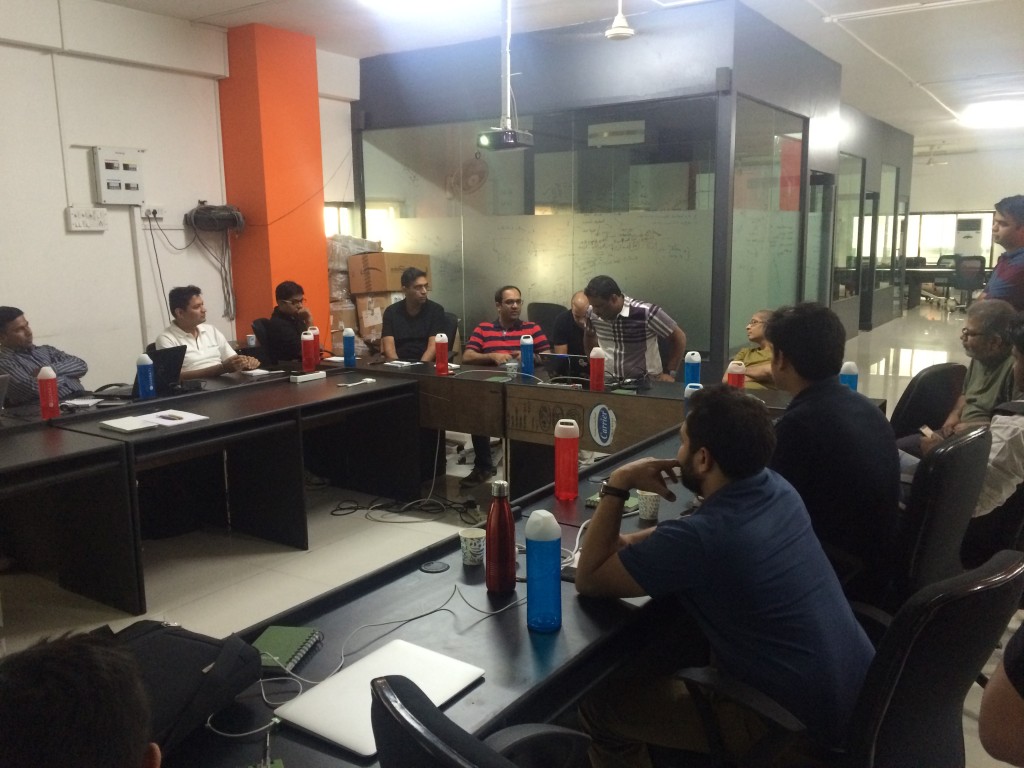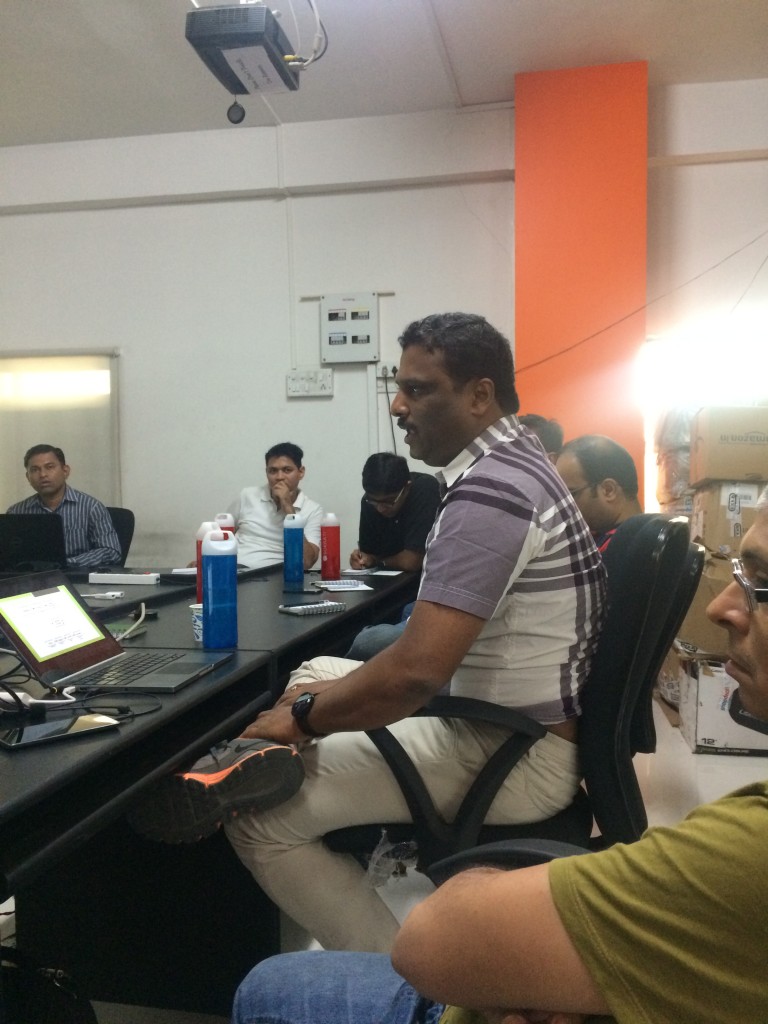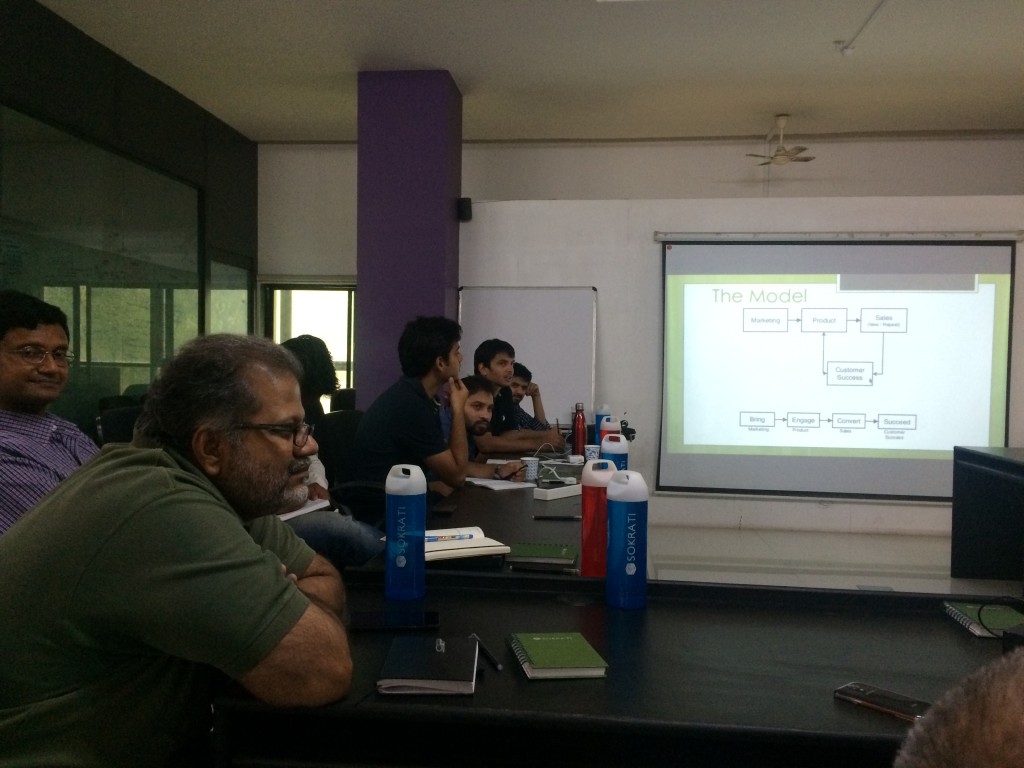Recently, India has seen many success stories of product startups in the SaaS category, which are building products for the global market. Here is what we did –
Suresh Sambandam, Founder and CEO of OrangeScape (the company behind KissFlow), in collaboration with the iSPIRT team, conducted the 49th #PlayBookRT on building SaaS products for the world. Sokrati (Pune) played a gracious host for this event, and saw around 14 product entrepreneurs from different cities.
Hosting iSPIRT #playbookRT PlaybookRoundTable @sokrati today!14 wow product startups discuss customer success in USA! pic.twitter.com/7zyJEHOBi6
— Sokrati (@sokrati) May 30, 2015
Avinash Raghava introduced Suresh and the RT was kicked off with a round of introduction from all the participants.
Suresh laid out the purpose of the round table and defined the scope. This PlayBookRT was for the B2B SaaS startups with a product that has a global audience. These companies have achieved a product-market fit with a MRR (Monthly Recurring Revenue) in the range of $1K to $5K. These companies are looking to move the needle to $50K-$100K MRR. Essentially, early startups that are looking to grow at least 110x.
B2B customers need to be segmented with certain metrics. For KissFlow, the number of employees was a key metric to identify customer segments. The segments were –
- SOHO (<10 employees),
- Very Small Business (10-50),
- SMB (50-500),
- Mid-Market (500-5000) and
- Enterprises (5000+)
Depending on your product, you may segment the customers by their revenues.
It is unlikely that your product will work across all segments as it is. The sweet spot for KissFlow is the SMB and Mid Market, as the value proposition is stronger for these customers. You have to pick your own sweet spot.
There was some discussion on why Enterprise segment is different from the others. There were multiple views on that. It was discussed that the marketing and sales processes are different for large customers. Their buying process is different too. They want “vendors” to come to them. Often, the product itself doesn’t work. Example – for KissFlow, Enterprise’s would need integration with their existing systems like SAP or Oracle. The SMB or Mid-Market customers do not have such requirements. For enterprises, you may have to package your product as a custom solution. Instead of the entire company, you may find it easier to get your product rolled out in a specific department.
The Mid-Market segment opens a big opportunity in US market. Typically, in the US, $5,000 is the approval limit in this segment. Most of the SaaS products fit in this limit. That makes decision making easier and fast. These companies are willing to spend money on products that help them compete with big guys.

The discussion then moved on to the core elements of a successful SaaS business.
The role of the product in SaaS is very high. For enterprise products, the product comes at the end of the sales cycle. For SaaS products, the opposite is true. So, your product has to solve a problem.
While product is at the core of your business, marketing comes before the product. Your marketing communication needs to match the product promise.
Before accelerating your marketing, you need to decide on the product positioning. Your product is either a category creator, or provides a novel approach to an existing and well-understood category, or low cost alternative. Often, most of the SaaS businesses will fall in the second or third category. It’s also possible that product positioning could be mix of last two categories. The category creator products are hardest to pull off. The low-cost alternative need not be a low-priced alternative. Being in India, we can enjoy the advantage of low cost structures. Some companies do pass on the cost benefits to the customer via low price. While offering a low price option, it is important to ensure that you are not perceived as a low-quality option.
The next topic of discussion was offering a Freemium product vs Free trial. Often, for SaaS, this choice does not depend on the cost. The general consensus seemed to emerge that a free trial is the best option. Even if it doesn’t cost you much to offer part of the product for free, the effort to convert that free user to being a ‘paid’ user is high. Plus, when the user is ready to pay for the product, the user still may go out to look for other options. There are “free” products that make you pay with say a link to their website. This is not really free as your customers are paying with a different currency.
Like all discussions, this one too took a detour and we discussed about sales for the global customer base. To serve the US market, you need to have a night shift. For KissFlow, the newly signed up customer receives two emails – one automated and one personal email. The automated email is to schedule a demo of the product. KISSFlow has reduced the friction to sign up dramatically. You sign up with just an email. They have a team to find out information about that person based on the email address. All the new leads get assigned to the sales team automatically based on timezones and available bandwidth with the sales team. Each sales person handles about 200 leads per month with an annual contract value of less than $5,000.

The next topic of discuss was pricing. People visit the homepage and then the ‘pricing’ page. They are qualifying themselves by looking at pricing. There are various ways to price your product. For the well-established category, competition will be a huge influencer in your pricing. You can also price your product based on value offered, though, you need to clearly demonstrate the value of the product. For KissFlow, the anchor was Google Apps. At the start, they focused on a niche of companies who have adopted Google Apps, which costs $5 per user per month. So, they picked the price of $3 per month.
For SaaS companies, raising the prices is usually not a problem. You can grandfather your existing customers who will continue to enjoy the same price, but the newer customers will pay a higher price. The real problem is lowering the prices, as it upsets existing customers. If your customers are not complaining about the prices, you are leaving money on the table and you should raise the price.
You should make users pay every month irrespective of their usage. You shouldn’t have to sell your product every month to the customers. That’s why your customers need to keep paying every month. Setting the expectations also ensures that customers are not thinking about pricing often.
Marketing was the next topic of discussion. Your website is a core marketing asset. You should avoid outsourcing the site development and have an in-house team for updating and maintaining the website.
Your home page should have a crisp headline with some value proposition. Jargon should be avoided. Make it easy for customers to understand and take a decision about your product. You should create a “customers” page for social proof. Highlight your major customers on this page. If you are running a blog, it will have visitors who are not aware about your product. You should create ads for your own product and run them on your blog.
You can use SEO and AdWords to bring the organic and paid traffic. SEO needs a lot of time to ramp up. So, start early with a dedicated team, even if it is a one-person team. AdWords needs a specialist to handle the paid traffic. Here, you can define your key metrics like costs per sign up. AdWords can deliver a sign up at $10-$25 for search and $2-$10 for display ads. These are only sign ups and not conversions. You need to measure conversion to paid subscription. That would be your true cost of customer acquisition.

You need to have a responsive site as mobile traffic is growing. Even though most business users will sign up for your product with a desktop, they might discover your product on the mobile (maybe while reading a blog). They need to have a good experience when they are on mobile.
You can run re-marketing ads. This will provide you multiple opportunities to reach out to the user. Test out different messaging in the re-targeting. You can do smarter remarketing by finding the users’ point of interaction. For paid ads, start with only the US and then keep adding more countries depending on the quality of the traffic. There was a brief discussion on content marketing, focused on the disciplined approach to creating valuable content that will start delivering results over a period of time.
This was an excellent round table that covered most of the aspects of building SaaS products for the global market.
Contributed by Shashikant Kore, Co-founder of Karooya.













